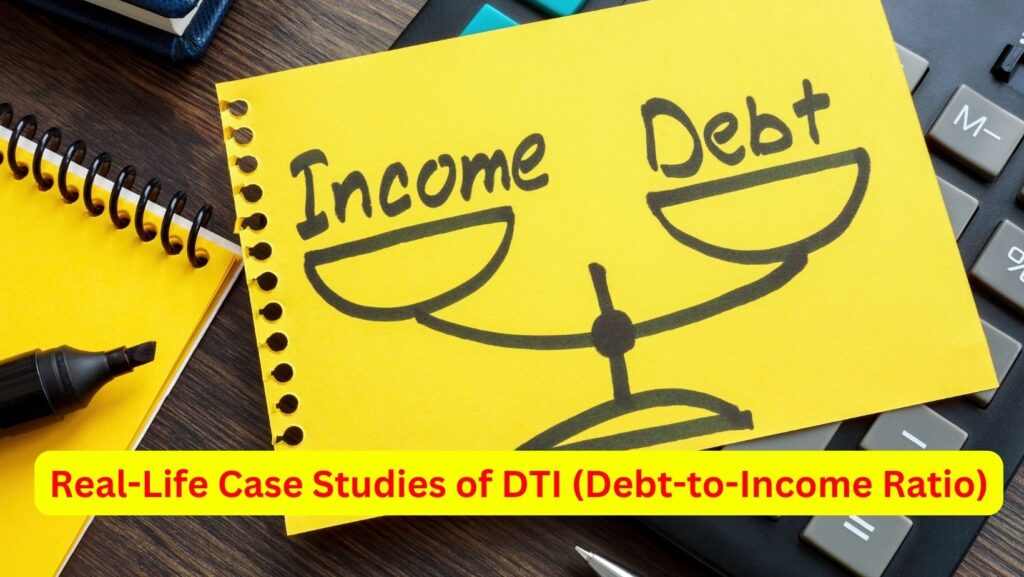In this blog, we go through real cases of DTI to help you figure out how to handle and improve your Debt-to-Income (DTI) Ratio. See how people and families managed high DTIs, what they did to fix it, and what happened if they didn’t. Explore how DTI considerations change at different life stages and how to monitor and maintain a healthy DTI for lasting financial well-being.

Real-Life Case Studies of DTI (Debt-to-Income Ratio)
Case Study 1: Managing High DTI Successfully
In this case study, we’ll examine how an individual successfully managed a high DTI:
Scenario: Nisha, a recent graduate, accumulated significant education loan debt while pursuing her education. Her DTI was high due to student loan payments.
Strategies: Nisha took several steps to manage her high DTI:
- She created a detailed budget that allowed her to allocate funds wisely, ensuring she could make debt payments while covering living expenses.
- Nisha explored income-boosting opportunities, including part-time work and freelancing.
- She combined her education loans (Debt Consolidation Strategy) to get lower interest rates, making them easier to handle.
Outcome: Over time, Nisha reduced her DTI and paid off her education loans. She was very good at handling her money and debt, so she improved her financial situation and started her journey to financial success.
Case Study 2: Strategies for Improving DTI
In this case study, we’ll explore how a family improved their DTI by implementing specific strategies:
Scenario: The Mehra family had accumulated credit card debt and a car loan, resulting in a high DTI. They wanted to reduce their DTI to improve their financial stability.
Strategies: Mr Mehra took the following steps to improve their DTI:
- They created a comprehensive debt repayment plan, prioritising higher-interest debts.
- The family trimmed unnecessary expenses from their budget, redirecting those funds toward debt repayment.
- Mr Mehra negotiated a salary raise at work, providing additional income to accelerate debt payoff.
Outcome: Through diligent efforts, they significantly reduced their DTI over time. Because their financial situation improved, they could reach big financial goals, like saving for their kids’ schooling and retirement.
Case Study 3: Consequences of a High DTI
In this case study, we’ll highlight the consequences of maintaining a high DTI:
Scenario: Rakesh had a consistently high DTI due to excessive credit card debt and multiple loans. He went on applying for fresh credit cards and loans to manage his existing loans.
Consequences: Rakesh’s high DTI had negative repercussions:
- His credit score suffered due to missed payments and excessive credit utilisation.
- He was continuously declined for new loans and credit cards, further limiting his financial options.
- Rakesh faced high interest rates on his existing debts, making it challenging to break the cycle of debt.
Lesson: This case study emphasises the importance of managing DTI responsibly. Rakesh’s experience is a cautionary tale about the consequences of ignoring a high DTI.
DTI and Different Life Stages
DTI considerations vary at different life stages. Let’s explore how DTI impacts individuals in different situations:
A. DTI Considerations for Recent Graduates
- Recent graduates often face education loan debt and may have limited income sources.
- DTI management is crucial to avoid financial stress and set a solid foundation for their financial future.
B. DTI in Mid-Career and Family Planning
- Individuals’ financial responsibilities increase as they progress in their careers and start families.
- Balancing debt payments with saving for significant life events requires careful DTI management.
C. DTI for Pre-Retirees and Retirees
- Pre-retirees and retirees must ensure a lower DTI as they transition to fixed incomes.
- Managing DTI well before retirement is essential to maintain financial security during retirement.
Monitoring and Maintaining a Healthy DTI
- Regular DTI check-ups are essential to track financial progress and promptly address any rising DTI concerns.
- Adjusting financial strategies as circumstances change ensures ongoing DTI health.
- Seeking professional advice, such as consulting a financial advisor, can provide valuable guidance in DTI management.
The Relationship Between DTI and Financial Well-being
- Balancing debt payments with financial goals is a crucial aspect of economic well-being.
- Achieving financial freedom through a healthy DTI can reduce financial stress and increase economic security.
- If you handle DTI well for a long time, it improves your credit score, gets you better loans, and helps you reach your big financial goals.
- These case studies and life stage considerations illustrate the real-world impact of DTI on individuals’ financial journeys.
Final Words
We’re finishing up our six-part series on DTI, and we’ve been talking about real stories and how DTI matters during different life stages. These studies have illuminated diverse scenarios and effective strategies for managing and improving DTI.
DTI’s significance at various life stages, such as recent graduates, mid-career professionals, and retirees, has been underscored. Regular DTI check-ups and professional financial advice are essential for maintaining DTI health.
The dynamic relationship between DTI and financial well-being emphasises balancing debt payments with financial goals. Managing DTI helps boost your credit score, get better loan deals, and reach long-term financial goals.
With this info, you can make wiser financial choices and strive for lasting economic prosperity. We hope you gained knowledge from this series and feel more in control of your financial journey.
